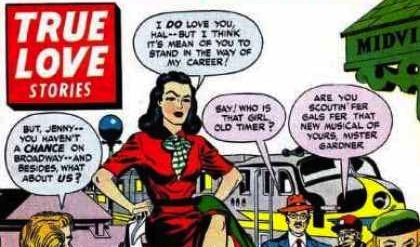Forbidden Love: I Read a Teen-Age Romance!
Supergirly

#le gasp!
Once upon a time, the competition tugging on Superman’s cape was a girl. Actually, a whole lot of them. Back in 1949, nearly one out of every five comics published was a romance. By early 1950, publishers were averaging two new romance issues a day.
Today, America’s lost that lovin’ feeling– collectors don’t much care for romance comics, they raise serious feminist concerns, and maybe you’ve never read one. But romance comics left behind a surprising legacy more epic than all those sleepless nights and tear-stained pillows.
Check the jump for 5 reasons to reconsider romance.
1. Not all of it was drivel
I won’t fight too hard for a genre infamous for telling young girls “being too loose with your lips” will lead to irrevocable ruin. (Bonus points for the implosion of the universe if you spurned the love of a rugged handsome man in favor of your dreams.) But I will say this:
Publishers didn’t create the American infatuation with docile women, they wrote in the context of it.
And within those constraints, even in a field populated by mainly by male writers, there exist some fleeting moments of redemption. Like the plastic surgeon who tells “ugly twin” of Romantic Adventures # 103
“There’s nothing I can do for you anymore—except tell you that looks are largely a measure of mental attitude! Go around shrinking from the world and acting like the Ugly Twin and that’s what you’ll be!”
Even more interesting was an unusual vignette in High School Confidential Diary #1 urging its audience to go to college at a time where high-paying manufacturing jobs were readily available.
For all its warped ideals and kitschy dialogue, romance comics did have their moments.
2. Love comics were a part of some amazing careers
Jack Kirby and Joe Simon created the first Young Romance #1 in 1947. Yes, that Jack Kirby. The man who helped create Captain America, the Fantastic Four, X-men and the Hulk was also a titan of treacle. Ronin Ro described romance comics as the duo’s “biggest hit in years” in his book Tales to Astonish: Jack Kirby, Stan Lee and the American Comic Book Revolution.
From there, romance comics never received much critical notoriety. But that didn’t stop some excellent artists from entering the field. Matt Baker, often called the most accomplished African American in comics during the 1940s and 50s by scholars such as Michelle Nolan, drew thousands of pages for romance companies like St. John.
As the honeymoon faded in the 1960s and romance was on its way out, Marvel even thrust Stan ‘The Man’ Lee into writing for the genre, before he was writing superhero novels.
3. And then the future!
Traditional romance comics slipped away in the 1970s, but comics that celebrate and dramatize relationships are fantastically alive.
“Strangers in Paridise” has been called “a Romance Comic For The 90’s”, lauded for its attempt to “single-handedly update an entire genre”. Personally, I wouldn’t call it a romance comic, but it does incorporate the screwiest love triangle I’ve ever read.
Gilbert Hernandez, of Love and Rockets fame, read Archie as a kid. (Yes, Archie was considered a love comic for a time.)
Many of today’s alternative graphic novels celebrate the candor of everyday life. Maybe they weren’t directly inspired by romance, but it’s pleasant to note that the audience for these stories lives on.
4. You can actually own a period piece
Remember how I said collectors don’t want these bad boys (girls?) ? Many Golden Age Comics can cost hundreds of dollars. Or way, way more if they are rare.
Consider this little experiment– A Thrills of Tomorrow #20 from 1955 with art from Jack Kirby in very fair condition may cost you $280. By comparison, a copy of Young Romance #42 from 1952 with art from Jack Kirby and Joe Simon goes for $90 in the same condition. (I’m sure there are other factors; send me a note in the comments!) Although they used to be quite literally a dime a dozen, romance comics are still manageable investments for the budding collector.
5. The Covers!

Robot love. Is there any other kind?
(second pic via SamuelsDesign.)
Megan Arellano also writes for Washington City Paper.
Have a tip we should know? [email protected]